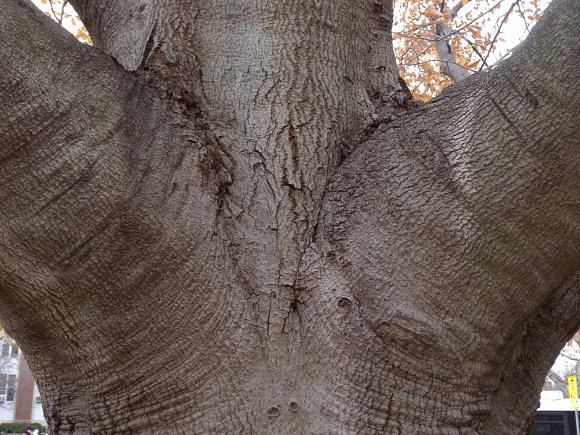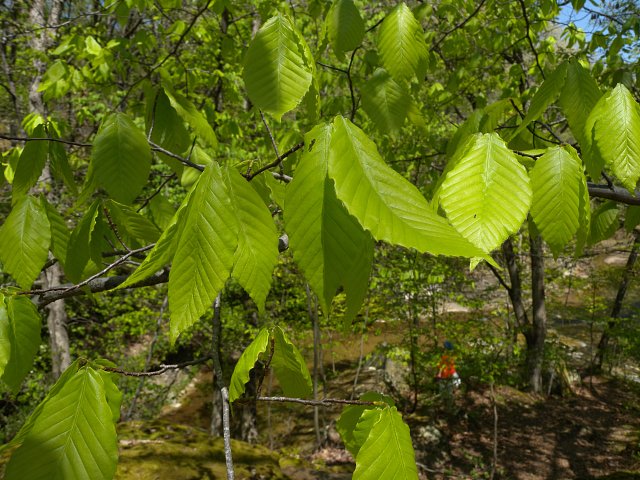Description: This tree is about 60-100' tall, forming a trunk about 1½–4' across and an ovoid crown. In open areas, the trunk is typically short and stout, while the crown is large. In forested areas, the trunk is long and limbless, while the crown is smaller in size. The bark of both trunk and larger branches is smooth and light gray, while the bark of twigs is brown and glabrous. Young leafy shoots are yellowish brown and sometimes sparsely hairy. Alternate leaves are 2½-6" long and ¾-2" across; they are oblong-elliptic to oblong-ovate in shape, while their margins have widely spaced incurved teeth. Each leaf has 10-14 lateral veins on each side. The upper surface of mature leaves is dark green, hairless, and shiny, while the lower surface is pale green, more dull, and hairless to sparsely hairy. The petioles are light green, rather short (½" in length or less), and glabrous or pubescent. The distinctive winter buds are up to ¾" long and narrowly ellipsoid in shape.

American Beech is monoecious; both male (staminate) and female (pistillate) flowers develop on the same tree as the leaves begin to emerge. Male flowers are arranged in globoid clusters from drooping hairy peduncles; the latter are about 2" long. Individual male flowers are about 1/8" (3 mm.) across, consisting of a hairy calyx with 4-8 lobes and several stamens. Female flowers occur in pairs on a stout peduncle; they are embedded in a body (involucre) of hairy scales and surrounded by several outer bracts. Individual bracts are pink to pinkish red and linear-lanceolate. Individual female flowers are about ¼" long and oblongoid-ovoid in shape, consisting of a calyx with 4-6 narrow lobes and a pistil with 3 styles. The blooming period occurs during the spring and lasts about 1 week; the flowers are cross-pollinated by the wind. Fertile female flowers are replaced by nuts with prickly husks. The husks are initially green, but they later turn brown as the nuts ripen; their prickles are curved. Each husk typically contains 2 nuts; individual nuts have an irregular triangular shape. The woody root system is shallow and branching. Sometimes vegetative shoots are produced when the root system is damaged. During the autumn, the deciduous leaves turn yellow or brown before falling to the ground.

Cultivation: The preference is full sun to medium shade, mesic conditions, and a rich loamy soil. The saplings of this tree can tolerate considerable shade. In some of the eastern states, individual trees are sometimes killed by Beech Bark disease, which is caused by one of several Nectria fungi. One symptom of this disease is discoloration and darkening of the bark. A parasitic flowering plant, Epifagus virginiana (Beechdrops), sometimes develops around the trunk of American Beech. It extracts nutrients from the shallow roots of this tree, but causes no real harm.
Range & Habitat: American Beech occurs occasionally in southern Illinois and the easternmost tier of counties in the central and NE sections of the state (see Distribution Map), where it is native. Illinois lies along the western range limit of this tree. Habitats include rich mesic woodlands, wooded slopes, bluffs, shady riverbanks, and better-drained areas in swamps. Because of its thin bark, this tree has poor tolerance of fire. In the absence of fire, American Beech becomes codominant with Sugar Maple (Acer saccharum) in the eastern deciduous forest. Because of its attractive bark and foliage, it is occasionally cultivated as a landscape tree.

Faunal Associations: American Beech is a host plant of many insect species, including the larvae of wood-boring beetles, weevils, plant bugs, aphids, leafhoppers, armored scale insects, mealybugs, larvae of wood wasps, and larvae of many moths (see Insect Table). The larvae of a butterfly, the Early Hairstreak (Erora laeta), feed on the leaves, flowers, and developing fruits of this tree. This butterfly occurs primarily in NE United States and the Appalachian region, where American Beech is more abundant. The fruits of this tree, beechnuts, are high in protein and fat. They are an important source of food to some bird species, including the Wood Duck, Passenger Pigeon (now extinct), Blue Jay, Rusty Blackbird, Common Grackle, Tufted Titmouse, Ruffed Grouse, Wild Turkey, Pileated Woodpecker, Red-bellied Woodpecker, White-breasted Nuthatch, and Carolina Parakeet (now extinct). The buds and flowers are eaten by such birds as the Rose-breasted Grosbeak, Purple Finch, and Ruffed Grouse, while the Yellow-bellied Sapsucker drills holes into the bark to feed on this tree's sap (Martin et al., 1951/1961; DeVore et al., 2004; Schorger, 1955; Bennetts, 1900; Snyder, 2004). Among mammals, beechnuts are eaten by the Gray Fox, White-footed Mouse, Deer Mouse, American Porcupine, Raccoon, American Black Bear, Southern Flying Squirrel, Eastern Gray Squirrel, Fox Squirrel, American Red Squirrel, and Eastern Chipmunk. The leaves and twigs of this tree are browsed by the American Moose and Elk, while the American Porcupine feeds on the bark (Martin et al., 1951/1961; Hamilton, 1941; Beeman & Pelton, 1980; Schneider et al., 2006; Ludewig & Bowyer, 1985). American Beech is sometimes selected as a nest site by various songbirds, including the Scarlet Tanager, Black-throated Blue Warbler, Cerulean Warbler, and Veery (Newell & Rodewald, 2011; Steele, 1993). This tree is sometimes used as a roost site for Rafinesque's Big-eared Bat and the Big Brown Bat (C. Martin et al., 2011; Agosta, 2002).

Photographic Location: The photos were taken at the campus of the University of Illinois in Urbana, and at The Potholes in west-central Indiana.
Comments: The outstanding characteristic of American Beech is its smooth gray bark. Sometimes, this tree is disfigured by people who carve their initials into the bark – such disfigurement can persist for decades. In urban and suburban areas, the European Beech (Fagus sylvatica), is often cultivated. This latter tree is similar in appearance to American Beech and can be confused with it. They can be distinguished from each other by the characteristics of their leaves and the prickles of their husked nuts. Compared to American Beech, the leaves of European Beech are more broad in shape and they have fewer lateral veins (less than 10 on each side). The teeth of its leaves, if they are even present, are less distinct than those of American Beech. While the husks on the nuts of European Beech have straight prickles, those on American Beech have curved prickles.